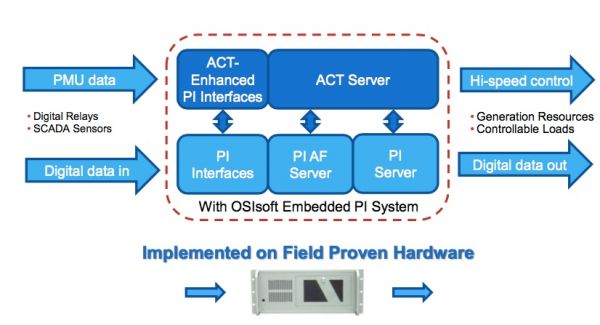One of the biggest challenges at the grid edge is integrating the real-time data from distributed energy resources (DERs) like solar, batteries, EVs and demand response into grid operations. Pxise, a startup jointly developed by California utility company Sempra Energy and utility data software vendor OSIsoft, says its software is up to the challenge.
Pxise -- pronounced like “spice” without the “s” -- was born from a collaboration between Sempra, OSIsoft and researchers at the University of California at San Diego, and was formally launched in December. But it has been testing its software for more than a year, at sites including a Sempra-owned battery-backed wind farm at an undisclosed location, Pxise CTO Chuck Wells said during a presentation at an OSIsoft user conference in San Francisco last month.
“With this technology, we can control the state of the grid at the point of interconnection,” he said. “The software isn’t limited just for one particular DER. We envision many DERs that may need controls. There could be 1,000 electric-vehicle chargers in a parking lot. This controller is specifically designed to manage 1,000 DERs, two-by-two decoupled, on one $3,500 box.”
The box in question is a hardened server, running a version of OSIsoft’s PI software built to handle synchrophasors, he said. Synchrophasors scan grid data at high speeds, and are a common technology on the transmission grid. But their uses on the low-voltage distribution grid have so far been limited to a few pilot projects, centered on data collection.

The grid increasingly needs real-time data, said UCSD professor Raymond de Callafon, whose research into model identification, estimation and control is built into Pxise's decoupled controls.
Today’s SCADA control systems work at second-by-second timescales, he said. That was suitable when big generators provided stability to the grid. But it’s too slow for the more sensitive grid management challenges that come with two-way, intermittent power flows from wind and solar, like the ones that Sempra-owned utility San Diego Gas & Electric is facing.
Meanwhile, the capabilities of the inverters turning renewable energy into grid-ready power aren’t being utilized to their fullest extent, said de Callafon. Smart inverters are providing reactive power and ramping support in pilot projects today. But this is usually done via a combination of automated set points and traditional SCADA controls, which limits their speed and flexibility.
Pxise, by contrast, puts multiple inverters, batteries, and other flexible energy resources into a kind of self-balancing mode, he said. “Because we’re measuring things very fast, we can manage things with little or no inertia, such as a microgrid with relatively little spinning reserves” -- something that’s hard to do with today’s control systems.
That makes the startup's approach significantly different from the network flow models used for most of the microgrid controls in use today, Wells said. “We use a simplified reduced model. This is Raymond’s specialty...you plug it in and turn it on, and the controller will work in a stable fashion and provide you good, robust control.”
But the startup’s core concept of two-by-two decoupled controls is a technology that dates back to World War I naval warfare, he said. “The ship rolls, pitches and yaws -- you can’t simply aim the gun at where you think it’s gong to be,” he said. Similar technology was built into tanks in World War II, and is the basis of autopilot systems in today’s commercial airplanes.
In fact, one of OSIsoft’s foundational projects in the 1980s was a two-by-two decoupled controller for oil refinery hydrocracking units, a project that helped lead to development of the company’s core data historian software, he said. OSIsoft doesn’t do direct industrial or grid controls today, making Pxise a first step back into that business.
The biggest test of Pxise’s technology so far has been at the undisclosed Sempra wind farm, which is being controlled via secure Ethernet from a site 2,500 miles away.
“That’s real-time control in the cloud,” said Wells. In a test in early February, Pxise’s software finely adjusted inverters and battery states of charge to smooth the wind farm’s varying output, while simultaneously achieving a tenfold improvement in frequency stability, he said.
This chart below covers two phases of operation for Pxise's software, de Callafon said. In the first phase, using batteries to inject and absorb power, Pxise was able to keep wind farm output right on line with the control signals being sent out from the grid operator or utility it serves, represented by the heavy double sloping line. “Keep in mind, we don’t plan this -- we measure this and react to it.”

In the second phase, Pxise kicked in its frequency management capabilities, leading to a much tighter range of fluctuations as represented by the blue line, which previously varied.
The software also helped stabilize the phase angle of the wind farm's output by using its battery and inverters, as represented by the green line in the graph, Wells said. “This is a critical factor in how we control the grid -- the grid angle control drives the power in an AC systems."
Inverters enabled in this manner can actually outperform the power system stabilizers now used for the purpose at power plants around the world, he said. What’s more, by controlling each inverter’s P and Q settings -- i.e., their real and reactive power -- “we will control power flow direction in any grid with little or no inertia,” said Wells. All in all, “it’s a new way to conceive of a grid control system.”
Pxise is also looking at opportunities to deploy its technology in microgrid pilot projects with the California Energy Commission.
As for future projects, Wells noted that traditional SCADA systems, including even the latest advanced distribution management systems, are not using synchrophasors in their control systems -- “If you’re going to implement an advanced DMS, why not use it?”



